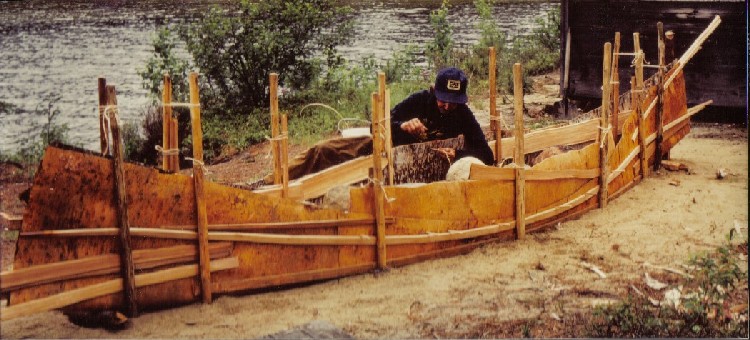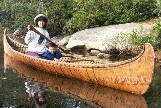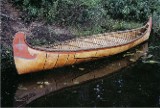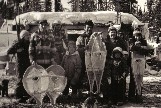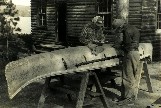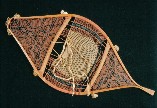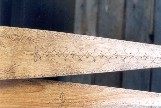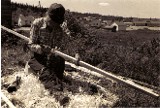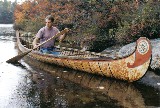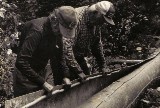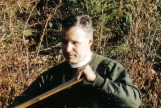|
Building an Algonquin
Birchbark Canoe
Constructing birchbark canoes among the Algonquin Indians of Maniwaki, Quebec
VHS, PAL format, DVD: 54 minutes
Henri Vaillancourt
|
Basil Smith sewing the seams of a new birchbark canoe ; from ''Building an
Algonquin Birchbark Canoe " ; photo Henri Vaillancourt , Maniwaki , Quebec
1980 |
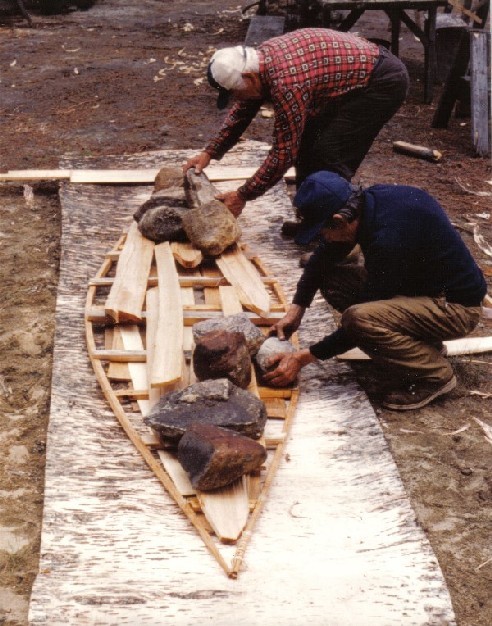 |
''Building an Algonquin
Birchbark Canoe'' follows the construction of a 14' "Wabanaki Chiman ''
canoe .This style of birchbark canoe [ literally ''Abnaki canoe'' ] came
into common use among the Algonquin towards the end of the 19th century
and generally replaced the old - form high ended style which had existed
since pre - contact times and had inspired the large fur trade birchbark
canoes developed by the French. The ''Wabanaki'' style was, in contrast to
the old form , simpler and quicker to build . Developed by the Abnaki in
southern Quebec, this canoe type quickly became popular among white
sportsmen for hunting and fishing, and this demand contributed to its'
adoption among the Algonquin and neighboring Ojibway.
Canoe building continued as a cottage industry into the latter part of
the twentieth century among the Algonquin of western Quebec, and in July
1980, Jocko Carle and Basil Smith, two elderly men from Maniwaki - and the
subjects of this documentary - built a birchbark canoe at their cabin on a
remote northern lake. The pair, friends and hunting - trapping partners
since childhood, regularly used the cabin as their base for hunting and
canoe building activities. Located just across the lake were the stands of
mature cedar needed for the framing of the canoe. And in the surrounding
forests were the large birches from which they peeled a sheet large enough
to cover the entire canoe, and dug the sinewy spruce roots that were used
for binding the wooden parts of the canoe and sewing the bark skin.
Working together the two men fashioned the gunnels , ribs , and planking
from cedar using axe and ''crooked knife'' and assembled the canoe on the
traditional sand bed . Ten days later on a warm summer evening , the canoe
was launched to glide noiselessly over the mirror smooth lake. |
|
Jocko and Basil begin
construction of a new birchbark canoe ; from ''Building an Algonquin
Birchbark Canoe'' ; photo Henri Vaillancourt ; Maniwaki , Quebec 1980 |
|
read more about:
''Building an Algonquin Birchbark Canoe'' |
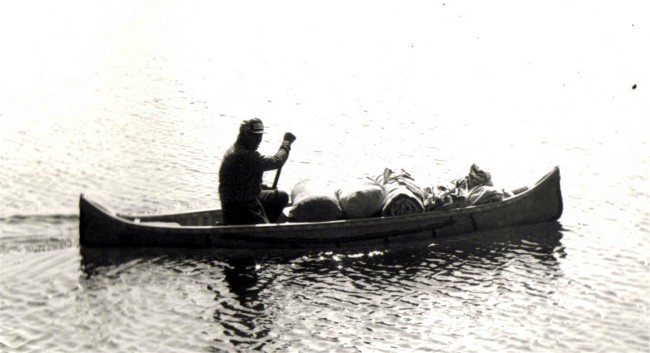 |
|
The finished birchbark canoe
being paddled on its maiden voyage. A 14' birchbark canoe such as this was
a popular size among white sports hunters and fishermen in the late 19th
and early 20th centuries ; from '' Building an Algonquin Birchbark Canoe
'' ; photo Henri Vaillancourt, Maniwaki Quebec 1980. |
|
|
|
Birchbark canoe building has
been practied without interruption from time immemorial to the present day
by the Algonquin of western Quebec and eastern Ontario . Whereas, in most
of North America , birchbark canoe construction and usage disappeared
sometime before the middle of the last century, it remained an intact part
of Algonquin material culture until the dawn of the 21st century.
There are several reasons for this unusual continuity among the Algonquin.
Perhaps most important is the geographical location of many of the
Algonquin communities. Being situated in sometimes fairly remote areas ,
they were less affected by the acculturation that took place among their
more southern neighbors living near non-native populations . Also,
Algonquin territory lay within a region historically known for some of the
best birchbark found in Canada and the U.S. . Although logging did occur
within this area , there remained vast tracts of woodland where excellent
material could be found. In contrast, the Algonquin's Cree and Montagnais
neighbors to the north occupy land where the birch is neither large nor of
good quality ; in the early 20th century, these canoe builders
transitioned to the readily available canvas as a substitute for birchbark
in canoe construction, retaining in the process, the methods and lines of
the original bark construction.This development took place as well in many
other parts of northern Canada and Alaska where economy and tradition
slowed the adoption of modern watercraft that was occurring in the more
acculturated southern Native communities
Lastly , towards the end of the 19th and early 20th centuries, the
manufacture of birchbark canoes for non-Natives became an important
economic activity for a large number of Algonquin families. This trade was
largely responsible for the retention of traditional canoe making skills
to the present day, as very few Algonquin actually used birchbark canoes
in the last half of the 20th century.
. |
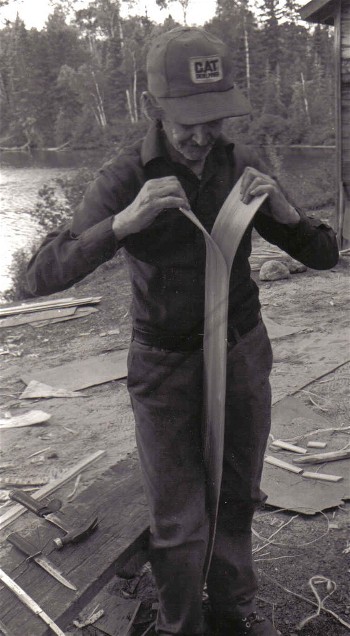 |
|
Basil splitting cedar for the
planking of a birchbark canoe ; from ''Building an Algonquin Birchbark
Canoe''; photo Henri Vaillancourt , Maniwaki , Quebec , 1980 |
|
|
|
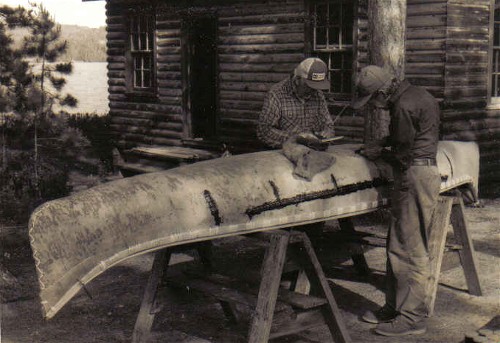
|
Thus , the stage was set for the
documentation in 1980 of the building of a birchbark canoe by Maniwaki
residents Jocko Carle and Basil Smith. Both men had worked independently
or with their families and others on numerous canoes in the 1930's, though
neither had done any building in recent years until the summer of 1979 .
For the video, they chose a lakeside cabin they regularly used for hunting
and fishing , and where they had recently built canoes .In the surrounding
forests were all the materials needed for the canoe. The pair first
scouted the surrounding area for a birch large enough to cover the canoe
in one piece, with the addition of sewn side panels to gain the necessary
width in the midsection. Several trees were found and two were felled and
peeled , the best being used as the main bottom sheet. Later that day , a
grove of young white spruce trees was found growing in an open area from
which a supply of long flexible roots was harvested for sewing and lashing
the bark and wooden framework. The bark and roots were then taken to camp
and placed in the lake to keep them fresh. |
|
Jocko and Basil pitching the
seams of the new birchbark canoe prior to launching ; from ''Building an
Algonquin Birchbark Canoe '' ; photo Henri Vaillancourt ; Maniwaki ,
Quebec , 1980 |
|
The following day, a short boat
ride across the lake brought them to a stand of tall white cedars. A large
straight grained tree was felled and split into the longitudinals to be
used for the canoe's gunnels . Shorter sections of the same trunk were
split into blanks for the ribs and planking of the canoe . The split
pieces were then loaded in the boat and taken back to camp.
Over the next 9 days , the men
constructed the canoe ; Basil peeled and split the roots while Jocko
prepared the wooden components with his axe and crooked knife. The men
then laid out the birchbark skin on the building bed...shaped it in the
form of the canoe... which Basil then sewed and lashed together . The two
then bent the ribs , which when dry, were installed along with the
planking to give the canoe its final shape . The completed hull was then
pitched with a mixture of pine rosin and grease. A mere 10 days after the
gathering of the material, the new canoe was launched in the evening from
the shore of the cabin. |
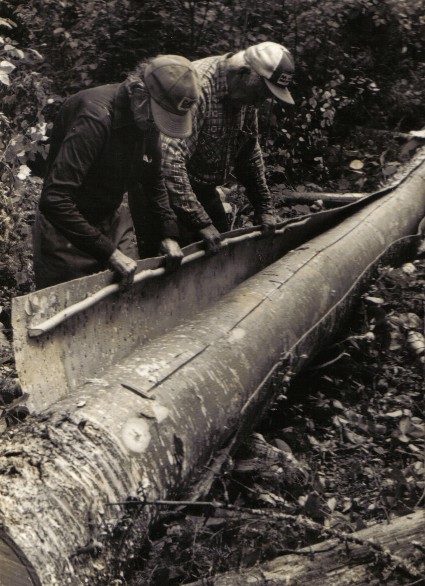 |
|
Peeling a sheet of bark for the
construction of a new birchbark canoe ; from ''Building an Algonquin
Birchbark canoe ''; photo Henri Vaillancourt ; Maniwaki Quebec , 1980 |
|
|
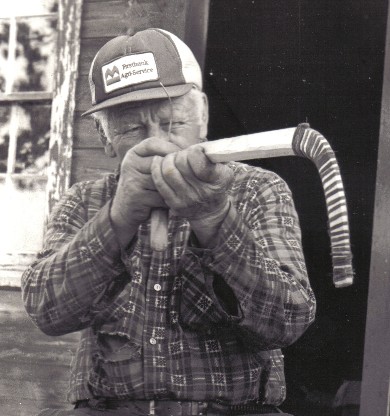 |
|
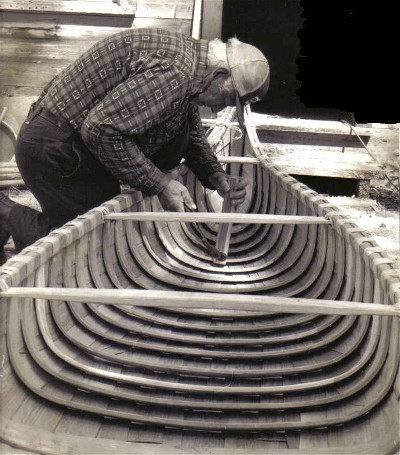 |
|
Jocko
Carle sighting along the bow piece of a new birchbark canoe ; from
''Building an Algonquin Birchbark Canoe '' ; photo Henri Vaillancourt ;
Maniwaki Quebec 1980 |
|
Pounding
the ribs into the hull of a new birchbark canoe ; from ''Building an
Algonquin Birchbark Canoe '' ; photo Henri Vaillancourt ; Maniwaki ,
Quebec 1980 |
|
